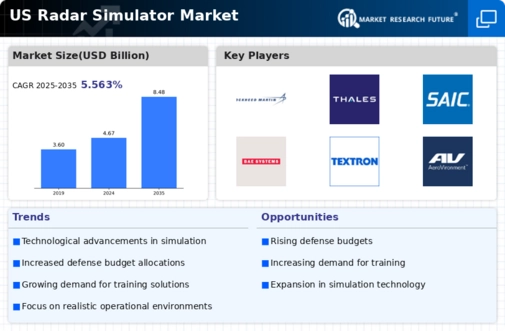The US Radar Simulator Market is characterized by a dynamic and competitive environment where various companies strive to innovate and improve their product offerings. This market is essential for military, aviation, and defense applications, where high-fidelity Radar simulators are crucial for training, testing, and operational purposes. Companies involved are constantly working to enhance their technological capabilities, reduce production costs, and improve user experiences through advanced software integrations and enhanced functionality. The competition is not only driven by technological advancements but also by the regulatory framework, demand for simulation-based training, and the increasing need for sophisticated radar systems in defense operations.
Firms are leveraging research and development as well as strategic partnerships to gain competitive advantages and capture a higher market share.Raytheon Technologies has established itself as a prominent player in the US Radar Simulator Market, with a significant focus on advanced sensing technologies and multi-domain operations. The company has a strong presence in both the civilian and military sectors, which bolsters its market position. Raytheon Technologies excels in providing comprehensive simulation systems that cater to various training needs, ensuring that personnel receive realistic and effective training experiences.
Its commitment to innovation, along with a robust portfolio of patented technologies, allows Raytheon Technologies to maintain a leadership position in the radar simulation domain, with continuous improvements addressing the evolving demands of defense organizations. Collaborations with military branches and the commitment to excellence in customer service further enhance its reputation and market strength.Lockheed Martin operates as a key player in the US Radar Simulator Market, known for its wide array of radar-related products and advanced training solutions. The company focuses on developing high-tech simulators that facilitate training for military personnel, ensuring preparedness for complex operational scenarios.
Lockheed Martin's strengths lie in its cutting-edge technologies, strong research and development capabilities, and its established relationships with government and defense sectors. The company has successfully engaged in mergers and acquisitions to enhance its technological assets and broaden its product offerings, allowing it to expand its market presence significantly. Key products include advanced radar simulation systems that integrate real-time data and analytics, contributing to enhanced training effectiveness and operational efficiency.
The focus on delivering customized solutions to meet the specific needs of clients solidifies Lockheed Martin’s position in the market and underscores its long-term strategy for growth within the US Radar Simulator Market.












